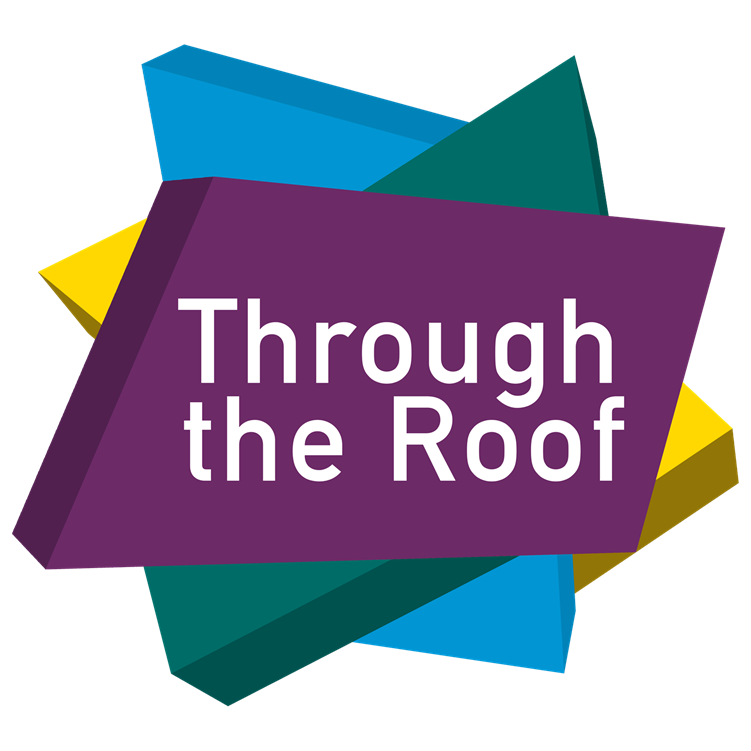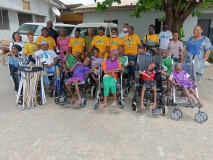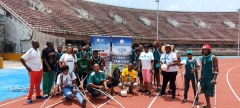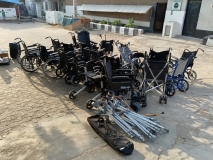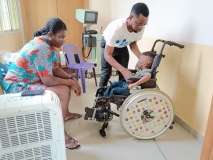Understanding Hidden Disabilities in the Church
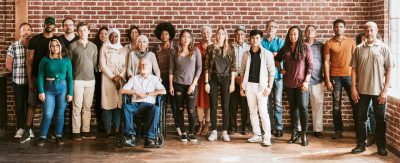
Walking into a church can feel daunting for anyone, but for people with hidden disabilities, this seemingly simple act can be a considerable barrier to overcome. If a church is unaware of its potential impact on people with hidden disabilities, it can lead to feeling isolated, excluded and unwelcome.
It’s essential that churches make sure everyone feels welcomed as part of the community – not just accepted but embraced too.
In this blog post, we’ll examine what these hidden or non-visible disabilities mean, highlight frequent misconceptions, and discuss how churches can embrace people whose conditions might usually stay unseen.
Key takeaways
- Hidden disabilities are conditions that can limit daily activities yet may not be readily visible to others. We need to challenge common misunderstandings that if a disability is less visible, it must be less severe.
- It is important to remove barriers and promote inclusivity for those with visible or invisible disabilities.
- The church can create an inclusive environment by recognising signs of hidden disabilities, offering support and understanding, providing assistive devices/mobility aids, supporting people by making reasonable adjustments (e.g. allowing people to sit to sing) & raising awareness about such conditions.
What are hidden disabilities?
A hidden disability, also known as an invisible disability or non-visible disability, is a physical or mental impairment that isn't immediately apparent to others. Unlike visible disabilities, easily identified through physical signs or mobility aids, hidden disabilities cannot be clearly seen from the outside. Despite not being immediately visible, these disabilities can significantly impact a person's daily activities, overall functioning, and well-being.
Examples of hidden disabilities
Here are some examples of hidden disabilities that you might encounter in your church, workplace, or community, but it's certainly not an exhaustive list:
- Chronic pain: Many different conditions, including fibromyalgia, complex regional pain syndrome (CRPS), and certain types of arthritis can lead to severe pain and discomfort, even though there may not be any visible signs.
- Mental health conditions: Mental health conditions like depression, anxiety disorders, bipolar disorder, and post-traumatic stress disorder (PTSD) are often classified as hidden disabilities because their symptoms are internal and not always apparent to others.
- Neurological conditions: Neurological conditions such as epilepsy, traumatic brain injury, multiple sclerosis (MS), and certain types of migraines can cause significant impairment, even without visible physical symptoms.
- Chronic illnesses: Chronic illnesses like irritable bowel syndrome (IBS) or chronic migraines may not have visible symptoms but can significantly impact a person's daily life. Chronic Fatigue Syndrome (CFS) is another example: CFS sufferers experience extreme fatigue and other symptoms that are not immediately noticeable to others.
- Autoimmune disorders: Autoimmune disorders like lupus, Crohn's disease, type 1 diabetes, or celiac disease can affect various organ systems and cause symptoms that are not externally visible.
- Learning disabilities: The impact of learning disabilities can be great, but they are often not obvious. According to the UK charity Mencap, Learning disabilities are when a person has a reduced intellectual ability and difficulty with everyday activities. (A learning disability is different from a learning difficulty, as a learning difficulty does not affect general intellect - see below.)
- Neurodivergence and learning difficulties: such as dyslexia, dyscalculia, attention-deficit/hyperactivity disorder (ADHD), or autism spectrum conditions can impact people’s lives hugely without visible signs.
- Sensory processing disorders: Conditions that affect how the brain processes sensory information, like autism or sensory processing disorder, may not have visible indicators.
The church, in particular, should support those with hidden disabilities, creating a more inclusive atmosphere, so that everyone feels fully able to access, participate in and contribute to church activities. People facing difficulties due to their invisible conditions may experience obstacles, including misunderstanding by others or a lack of acceptance, which makes it hard for them to cope with the situation without proper support from others.
How many people have hidden disabilities?
It is believed that approximately one in five individuals across the UK have a hidden disability which can hinder their daily activities yet may not be readily visible to others. It is also estimated that 70-80% of disabilities are non-visible. Contrary to common beliefs, these disabilities are just as serious and valid as other visible impairments.
Defining the number of people with less visible impairments can prove challenging, but the number of people is likely to be greater than government findings show, as examples could include those living with undiagnosed conditions like early-onset dementia, as well as conditions already mentioned such as fibromyalgia, multiple sclerosis, Lyme disease and autoimmune issues.
Dawn's story
The best way to understand the impact of hidden disabilities is to hear from someone who has one. Here is a testimony shared by a church member on Disability Awareness Sunday.
"My name is Dawn and I have hidden disabilities. The main symptoms I battle with are Chronic Pain and Physical and Mental fatigue.
One major challenge I face is that my abilities and needs vary from day to day because my pain and fatigue fluctuate. Some days I need bed rest or mental rest in a quiet environment, on other days I can interact in larger groups and manage a lot of communication.
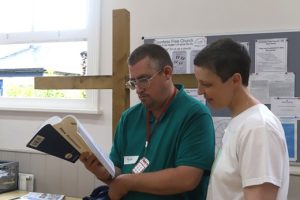 Sometimes people expect me to be able to do more than I am able because I look well. Then at other times, people don't ask me to do things when I am able because they don't want to overload me. I would always encourage you to ask the person what they feel they can give rather than to assume you know.
Sometimes people expect me to be able to do more than I am able because I look well. Then at other times, people don't ask me to do things when I am able because they don't want to overload me. I would always encourage you to ask the person what they feel they can give rather than to assume you know.
Planning things can be a challenge as when I look at my calendar to book events I don't know what my pain and fatigue levels are going to be like on this day. This can result in me doing too much because I don't like to let people down if I have committed to something.
Due to this I have been unable to have a paid job for the past 20 years and serve instead in voluntary roles that I can lay down. This has been an area I have had to learn to trust God's provision in.
I do get frustrated when my body and mind can't keep up with my desire to be active and serve. However, God has taken me on a journey and I have learnt from my disability that in order to function well, I need to live at a slower pace.
I have learnt that there is much blessing to be found in learning to slow down and live in the present moment. I hear God speaking more clearly as I take time to rest in his presence and seek to know what is on His heart.
I have found a deeper place of daily peace as I have learnt to surrender the need to be in control. God has taught me that He can be trusted to provide for my every need and work out circumstances in which I need a breakthrough; all He asks me to to is trust him and pray."
Dawn's story shows us that people with hidden disabilities face many challenges, but they are still used by God to serve Him, and their lived experience of disability can bring a lot of wisdom.
Common misconceptions
There are several common misconceptions about people with hidden disabilities, which can contribute to stigma and misunderstanding.
Here are some of these misconceptions:
- Misjudging people’s disability status: A common misunderstanding is that if a person doesn't show physical signs of disability, they must not be disabled. This can lead to scepticism or disbelief when individuals with hidden disabilities request reasonable adjustments or support for themselves, to have equal access.
- Doubting the severity: Some people may think hidden disabilities are less severe than visible ones. This misunderstanding overlooks the fact that hidden disabilities can significantly hinder a person's daily life, functioning, and overall well-being.
- Believing they're overstating: There is a misconception that individuals with hidden disabilities may be overstating their conditions or using them as excuses. This can lead to doubts about the legitimacy of their challenges and the need for support.
- Expecting consistent symptoms: People often expect individuals with hidden disabilities to be consistently "disabled" or symptomatic. However, many non-visible conditions can have fluctuating symptoms, meaning that someone may have good and bad days, or moments of being able to function well.
- Underestimating the impact: Many people underestimate the profound impact hidden disabilities can have on a person's life. They may not realise individuals' challenges in managing their conditions and the effort required to participate fully in society.
- Expecting visible indications: There's often an expectation that people with hidden disabilities should display visible signs of struggle or discomfort. When they don't, others may question the legitimacy of their needs.
- Believing people don't need support: Some individuals may think that because someone appears ‘normal’, they do not require any extra accommodations or support. This assumption can hinder access to necessary resources and help.
- Making assumptions about their abilities: People might judge what individuals with hidden disabilities can or cannot do based on their condition, overlooking their unique strengths and capabilities. Fluctuating symptoms add to this, so people with non-visible disabilities may be overlooked for a task, on an assumption of ill health.
- Stigmatising mental health: There can be significant stigma and misunderstandings in the case of hidden mental health conditions. People may wrongly assume that individuals can "snap out of it" or that their condition is less serious than physical disabilities.
It's crucial to challenge these misconceptions and foster a more inclusive and empathetic society. Churches in particular can play a key role in recognising that hidden disabilities are genuine and serious, and providing the necessary support and accommodations to help individuals thrive despite their challenges. Education and awareness can play a significant role in making this happen.
The truth is that hidden disabilities come in various forms; some may have permanent, continuous symptoms, while other symptoms may fluctuate. However, the impact on people's lives can be considerable, and the reasons behind their need for support can be complex. Any disability, visual or not, should not stop anyone from participating in church life. As Christians, we're called to love our neighbours, which also means creating an inclusive culture.
Hidden disability vs. invisible disability vs. non-visual disability: What is the right term?
It is essential to recognise the existence of disabilities that are not immediately observable. Terms like hidden, invisible and non-visible disability are often used interchangeably but refer to those conditions which aren’t easily seen by others.
People within the disability community have different views on the right term to refer to disabilities that aren't immediately obvious by looking at a person.
‘Hidden disability’: Hidden disability is the most commonly used term. However, some consider the term offensive as it could be argued that it suggests people purposefully withhold the fact they have a disability. There is a difference between choosing not to self-disclose that you have a disability versus actively hiding it.
‘Invisible disability’: For some people with disabilities, this term is also offensive. It suggests the person is not visible or that you cannot discern that a person has a disability, which is not always true. Non-apparent disabilities may become apparent, depending on the type of disability.
‘Non-visible disability’: More recently, the term non-visible disability has been used. You can find it on UK government websites in particular. It's a newer term, and, as such, not many people identify with it yet, but its use is growing. However, arguably, the same is true for ‘non-visible disability’ as for ‘invisible disability’ - that it could be taken to imply a general lack of visibility for the disabled person, though that is not the intention of the term.
The impact of hidden disabilities on daily life
Hidden disabilities can present a range of difficulties to the people they affect,from stigma and impaired accessibility to employment discrimination. Individuals with such impairments may have difficulty engaging in day-to-day activities. It is essential that the church takes action by offering support and acceptance for all members regardless of their physical or mental abilities. This enables their full participation within church life so they are not left feeling excluded from everyday activities due to any hidden disability issues they face.
Stigma and misunderstanding
The church can play a role in breaking down the walls that separate people with hidden disabilities and creating an atmosphere of acceptance by raising awareness about these conditions. With increased understanding, everyone who faces discrimination due to their invisible struggles will have access to much-needed support and be welcomed within the church family. These efforts make people feel less alone and isolated by society’s attitudes.
Accessibility challenges
Individuals with hidden disabilities may experience a lack of recognition and assistance. This can leave many obstacles preventing them from taking part in church and community life, which at best leads to displeasure for these individuals, and at worst can lead to loneliness and alienation. To foster inclusion within the church setting, appropriate arrangements should be made to allow all to participate in worship services, as well as other group activities. However, access is not the only step that is needed for full disability inclusion.
Not being enabled to serve and to belong
A common issue for people with disabilities - including those with hidden disabilities - is the sense of being overlooked, so their gifts and talents are not being recognised or used in church life. In an eagerness to respond to hidden disabilities, churches can make assumptions about what people can or can’t do, without asking the individuals concerned. This can lead to a sense of frustration at not being able to serve or take on responsibilities. Fluctuating symptoms can be common with hidden disabilities, so don’t assume people are unable to do help due to their disability. The best thing is to ask in each instance. Using our God-given gifts is so important to each of us, so we feel we belong as part of the community.
Employment discrimination
To dismantle barriers and create a more inclusive workplace for individuals with hidden disabilities, it is essential to increase awareness and establish effective policies. Hidden disabilities can significantly impact one’s ability to secure gainful employment, attain higher wages, or experience job satisfaction—issues that must be addressed to eliminate discrimination in society. Churches can lead by example, ensuring they are modelling best practice in equal opportunities, and advocating for people with hidden disabilities, so the church helps everyone to have equal access to finding meaningful work or employment.
Identifying and supporting hidden disabilities in others
The church can foster an environment where everyone feels welcomed and accepted by noticing signs of hidden disabilities, providing support, and promoting disability inclusion. Identifying those with hidden disabilities and discreetly providing any support they need, allows them to grow without prejudice or judgement while giving essential care for their unique needs.
Recognising signs and symptoms
Church members should look out for signs and symptoms that could suggest a hidden disability so they can offer support, where needed. Possible signs might include wearing hearing aids, injecting medication, or needing time out from a noisy room. However, there may be no outward signs, so it is up to the individual whether they want to tell others about any disability. It is important to respect privacy and not force people into sharing personal information. Recognising any signs and symptoms is a useful step though, so you can discreetly offer appropriate aid when necessary. But do not be offended if it is not accepted.
Offering support and understanding
Providing assistance, compassion, and understanding can significantly help those with hidden disabilities. With support from their church community, they may feel appreciated and accepted within it. It is vital to bear in mind that individuals might be unable to communicate how they feel effectively, due to hidden disabilities preventing them from doing so, or because they have experienced negative attitudes in the past. This means offering help is all the more valuable. Encouragement could make a huge difference among people suffering silently with invisible impairments.
Making it possible for everyone to take part
Providing physical access, granting accommodations or adjustments as needed, and fostering an inviting atmosphere can all contribute to making sure people with disabilities have full involvement within church life. Sometimes what people need is just a small thing that can make a big difference - such as a chair with arm-rests, located near the door. Sometimes the needs might mean more organisation, such as a sign language interpreter, or subtitles and voice over adding to a video. Whatever the need, it is important to do something about needs presented in a church or community, so everyone is included.
Support and accommodations for people with hidden disabilities
To create a warm and accepting environment for all, including those with hidden disabilities, providing support is key. This could include offering assistive devices or raising awareness about different types of conditions to increase understanding. Advocating for inclusive policies that ensure everyone is accommodated also helps fulfil the church’s mission. All these efforts empower people living with disabilities so they have equal opportunities in church and community life.
Assistive devices and support aids
Having support aids available can help with certain hidden disabilities. 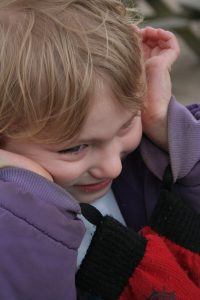 For autistic individuals, these might include ear defenders or a quiet areas to help combat noise - or fidget toys, or colouring sheets, which may act as an aid to concentration. For others it may be as simple as not requiring everyone to stay standing for long periods, or having some chairs available at a standing event. Access to such additional resources can allow those with a hidden disability to participate fully in church services, activities and community engagements. Providing such helpful assistance can empower disabled individuals who may otherwise face difficulties integrating into society due to barriers they confront on a day-to-day basis.
For autistic individuals, these might include ear defenders or a quiet areas to help combat noise - or fidget toys, or colouring sheets, which may act as an aid to concentration. For others it may be as simple as not requiring everyone to stay standing for long periods, or having some chairs available at a standing event. Access to such additional resources can allow those with a hidden disability to participate fully in church services, activities and community engagements. Providing such helpful assistance can empower disabled individuals who may otherwise face difficulties integrating into society due to barriers they confront on a day-to-day basis.
Raising awareness and advocacy
By raising awareness and advocating, the church can create an atmosphere of acceptance for individuals with disabilities. Through education on hidden impairments and pushing for comprehensive policies that embrace diversity, understanding is fostered to ensure everyone within the congregation has equal opportunity.
Accommodations and reasonable adjustments
The church can provide equal opportunities for people with invisible disabilities by creating reasonable adjustments. These could include ergonomic furniture, assistive technology and flexible work hours to enable access to available mental health services. By offering these accommodations, individuals affected will be able to participate actively in worship activities and community life despite any difficulties they may have due to their hidden disability or ailments related to that.
The hidden disabilities sunflower initiative
The Hidden Disabilities Sunflower Initiative strives to make hidden disabilities more recognisable and understood by the public through raising awareness about them. By providing a discreet ID symbol for those with invisible ailments, it encourages acceptance and breaks down any barriers caused by lack of knowledge or understanding.
Origins and Purpose
The Hidden Disabilities Sunflower Initiative seeks to create a more comfortable and accepting atmosphere for people with hidden disabilities when they go out. Through raising awareness of their condition so that society is better informed about it, churches may be able to provide suitable support and aid them as equal members into all its activities.
How It Works
The Hidden Disabilities Sunflower Initiative is a service that helps people with hidden disabilities to communicate their needs and access required assistance. This is done through an identifiable symbol – such as a sunflower lanyard – allowing those living with invisible impairments to show others, like personnel or healthcare professionals, what they may require.
Impact on Awareness and Acceptance
The Hidden Disabilities Sunflower Initiative has effectively raised awareness and acceptance of hidden disabilities. This unique initiative offers a discreet way for people with invisible impairments to alert service providers that they may need additional help or assistance, ultimately reducing misunderstanding towards those living with undisclosed conditions.
You can read more about this initiative in our blog The sunflower lanyard and what churches should know about it.
Accommodating hidden disabilities in the church
Creating an atmosphere of acceptance, accommodating different needs and engaging with those with hidden disabilities are all essential components in fostering a church that is open and accessible to everyone. By considering potential obstacles ahead of time, the church community can ensure it remains inclusive for individuals regardless of their abilities.
Culture of acceptance
The church can create an atmosphere of acceptance by recognising signs and symptoms associated with hidden disabilities and fostering understanding and empathy. This will help eliminate any barriers to participation in the congregation for those living with a disability they may feel uncomfortable discussing, enabling them to be welcomed into a supportive environment.
Willing to change
To make a church atmosphere accessible for everyone, the willingness to change and adjust is necessary. By setting up relevant assistance as well as spreading inclusivity, people with concealed disabilities can better take part in services, events and life among congregation members. Creating an inviting environment where everybody feels included is essential for a church’s success, particularly for individuals dealing with impairments.
Anticipatory duty
The church should anticipate potential obstacles for those with disabilities and strive to overcome them. This includes providing physical access such as ramps or elevators as well as accommodations such as allowing people to sit to sing or providing access to large print song sheets. By taking a proactive approach, the needs of people with disabilities can be properly met so they do not encounter barriers due to their condition.
Speak to people with hidden disabilities
By talking with individuals with hidden disabilities, the church can gain an understanding of their unique challenges and create a more inclusive atmosphere. This communication allows needs to be met, fostering an environment that supports all its members.
Summary
We should strive to make our church an inclusive and supportive environment by understanding hidden disabilities, offering suitable accommodations and support, and promoting disability inclusion as well as accessibility for all members. By doing so, we can ensure that everyone can participate in worship or community life without discrimination according to their abilities. Let us accept the diversity of people within our congregation while working collaboratively to create a place where everyone feels accepted and appreciated equally.
Further support for churches
Through the Roof’s can support your church with practical ways to support people with hidden disabilities. Our Roofbreaker project can provide you with free resources, such as the Church Disability Toolkit and Removing Barriers audit.
Click on the following link to become a Roofbreaker and join with over 600 others across the UK as part of a growing network who are actively making adaptations for disabled people to access and belong to God’s family.
New life in Nigeria 2024 Wheels for the World blog
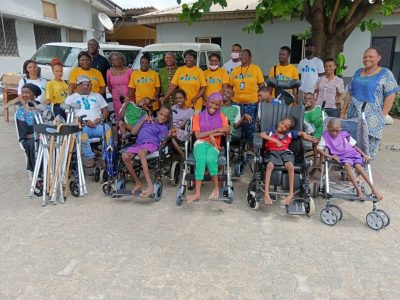
Our Wheels for the World team in the UK helped support the distribution of life-changing mobility aids to many disabled people in Lagos and Delta State, Nigeria, in March/April 2024.
Over 80 million disabled people worldwide need a wheelchair but don’t have the money or opportunity to buy one (WHO). Wheels for the World seeks to change that situation by refurbishing disused wheelchairs from donors in the UK, including the NHS, making them as-new. The chairs are then shipped overseas and therapists fit them to individuals' needs.
Bringing freedom
In March 2024, we partnered with the charity Osteogenesis Imperfecta Foundation Nigeria whose therapists fitted local disabled people with appropriate equipment. Over 200 mobility aids and 140 wheelchairs were distributed, which had been refurbished in our UK Wheels for the World warehouse. Our UK team of therapists and techies were available online to support the remote distribution. Many of the disabled people had never had a wheelchair before, or were using old or broken equipment that was not fit for purpose.
The team also gave out 250 Bibles to individuals - giving spiritual as well as physical freedom to all. It was such a blessed event. Disabled individuals ranging from age 2 to over 50 years old were given equipment to rejuvenate their lives and empower them for a more positive way of living.
The supported Wheels for the World distribution was organised by Tarela Aghanti, Director and Founder of Osteogenesis Imperfecta Foundation Nigeria (OIF Nigeria). Tarela led the local team on the ground, sending stories and images of the many lives changed for the better on the mission. Here are just a few of the stories she shared about the impact of this work.
Modupe Cole Memorial Childcare Home
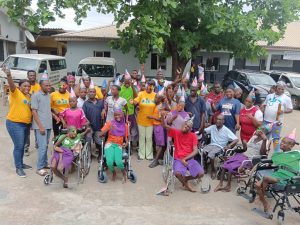 The mission team visited one of the oldest children’s homes in Lagos, the Modupe Cole Memorial Childcare & Treatment Home School. They were able to present 19 wheelchairs, 5 crutches, 4 walking sticks, 3 tri-walkers and 1 walking frame - along with stationery items as well as food and clothing. The children were so excited at the gifts and were dancing and filled with joy. The experience was not all positive however, as the team found the facilities at the home showed a great need for investment in equipment and more opportunities for the children to interact with others and learn/develop. We pray that the local government and community will recognise the need to support and encourage these disabled children. We were glad to be able to bring them some gifts and showed that people care about their needs.
The mission team visited one of the oldest children’s homes in Lagos, the Modupe Cole Memorial Childcare & Treatment Home School. They were able to present 19 wheelchairs, 5 crutches, 4 walking sticks, 3 tri-walkers and 1 walking frame - along with stationery items as well as food and clothing. The children were so excited at the gifts and were dancing and filled with joy. The experience was not all positive however, as the team found the facilities at the home showed a great need for investment in equipment and more opportunities for the children to interact with others and learn/develop. We pray that the local government and community will recognise the need to support and encourage these disabled children. We were glad to be able to bring them some gifts and showed that people care about their needs.
‘Special Eagles’ Amputee Football Team
Disability affects us all, including sports people. Tarela from OIF Nigeria was contacted by the 'Special Eagles' amputee football team who represent the whole of Nigeria, asking if they could receive mobility equipment to help them compete in football matches. So the mission team found themselves in contrasting surroundings, moving from a children's home to the giant National Stadium! The captain of the amputee football team, Sarafadeen Oyeleke, said: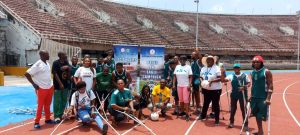
"I extend our heartfelt gratitude for your generous donation of pairs of crutches to twenty amputee players, both male and female. Your timely gesture has provided essential support that is invaluable to our team. The significance of these crutches cannot be overstated. They are not merely tools for mobility, they are fundamental to our ability to participate in amputee football. Your generosity will undoubtedly motivate and inspire our team as we prepare for the African Amputee Nations Cup in Egypt.”
Meet Perry
It was a positive atmosphere at the wheelchair distribution in Lagos, Nigeria. Perry, the youngest of the wheelchair recipients, has a brittle bone condition. He did not have a wheelchair, so had to be carried everywhere.
His mother, Mrs Sekinat, said: "Perry was born with osteogenesis imperfecta (OI) also know as brittle bone disease: a condition that causes the bone to fracture or break easily. I wasn't aware of my son's condition until I had a scan at 7th month of his pregnancy, then the sonographer told me my son's limbs are short that he is likely to have Dwarfism. When I gave birth to him (normal delivery), his legs were bowed. I think he fractured when I gave birth to him, as I carried him home and he cried often - then his hand was swollen like the bone was broken."
Mrs Sekinat was full of joy as she pushed her son home, strapped into his new chair. Perry's was dancing with excitement at getting his own wheelchair!
Thank you, Mr Friday!
Meet Dare
Meet Dare, aged 30, from Lagos, Nigeria - whose life is transformed through the gift of a wheelchair. Dare is a graduate of Biology Education who came to the Lagos wheelchair distribution to find help so he could continue his studies. He says: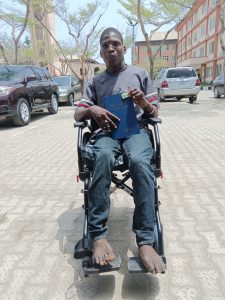
"I am living with cerebral palsy as occasioned from birth. Its been very challenging growing and having to go through my day to day activities. It really has been traumatising for knowing I can't lead a normal day to day life like my peers. Academically, it was frustrating because there were no specialised centres where I could write my entry examination. As a result I couldn't score the required mark to study my preferred course Medicine and Surgery.
